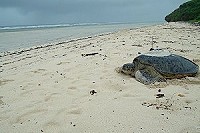 Definition:
Definition:
A marine protected area is essentially a space in the ocean where human activities are more strictly regulated than the surrounding waters - similar to parks on land. They can serve a variety of ecological and social purposes. The IUCN definition is one of several formal ways to define the concept broadly: “A clearly defined geographical space, recognised, dedicated and managed, through legal or other effective means, to achieve the long-term conservation of nature with associated ecosystem services and cultural values”.
Some facts:
-
Even though more than 2/3 of the Earth's surface is covered by oceans, around 3 percent are officially protected.
-
The Johannesburg Plan of Implementation (JPoI) adopted by Heads of State and Government 2002 in Johannesburg, South Africa at the World Summit on Sustainable Development mandates the establishment of networks of Marine Protected Areas by 2012 in order to support to goal of restoring degraded stocks, to the extent possible, by 2015 so that they can be harvested sustainably.
-
A recent assessment suggests that perhaps only 2% is effectively protected. Hardly any MPAs are conceived as networks to help achieve the broad-based multiple objectives pursued. An atlas of MPAs around the world is available here.
- Under the Convention on Biological Diversity (CBD) the parties have agreed on Aichi Target 11:
By 2020, at least 17 per cent of terrestrial and inland water, and 10 per cent of coastal and marine areas, especially areas of particular importance for biodiversity and ecosystem services, are conserved through effectively and equitably managed, ecologically representative and well connected systems of protected areas and other effective area-based conservation measures, and integrated into the wider landscapes and seascapes. -
Small MPAs may not be able to deliver the expected biodiversity and ecosystem services. Nevertheless, fisheries no-take zones have often worked as can be seen by air or satellite photos showing fishing vessels concentrated at their outer confined to enjoy the higher catches arising from spill over effects of a regenerating ecosystem within the protected area.
-
MPAs are an insurance policy against further decline and future losses. This is because it is increasingly understood that ecosystems which suffer from prolonged and massive reduction of abundance of major species do not recover easily to their earlier healthy state. The collapse of the once enormously rich cod fishery in Newfoundland, Canada, is a still hotly debated case in point.
Look up whether there is an MPA in your vicinity. Go to www.fishbase.org and look up the MPA tool on the search page under 'Information by country/island'. This search mechanism deep-links into the world MPA Database. If you want to go directly and learn more about this database, click here.
A rigorous comparative analysis of MPAs in different parts of the world was carried out by the INCOFISH research project. Read the report here.








